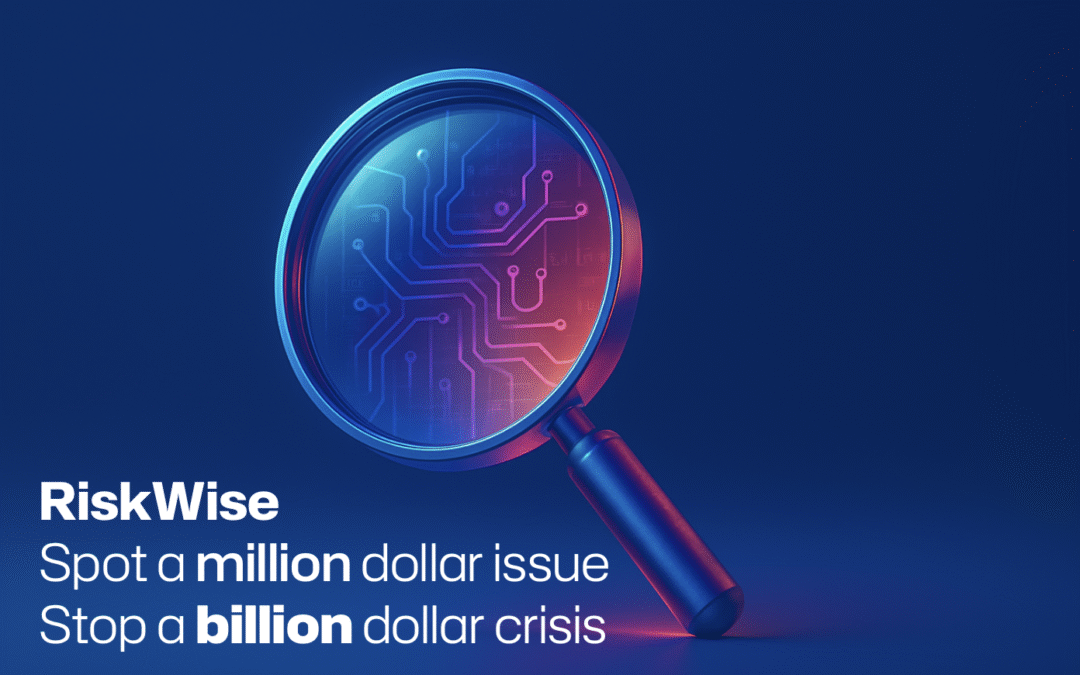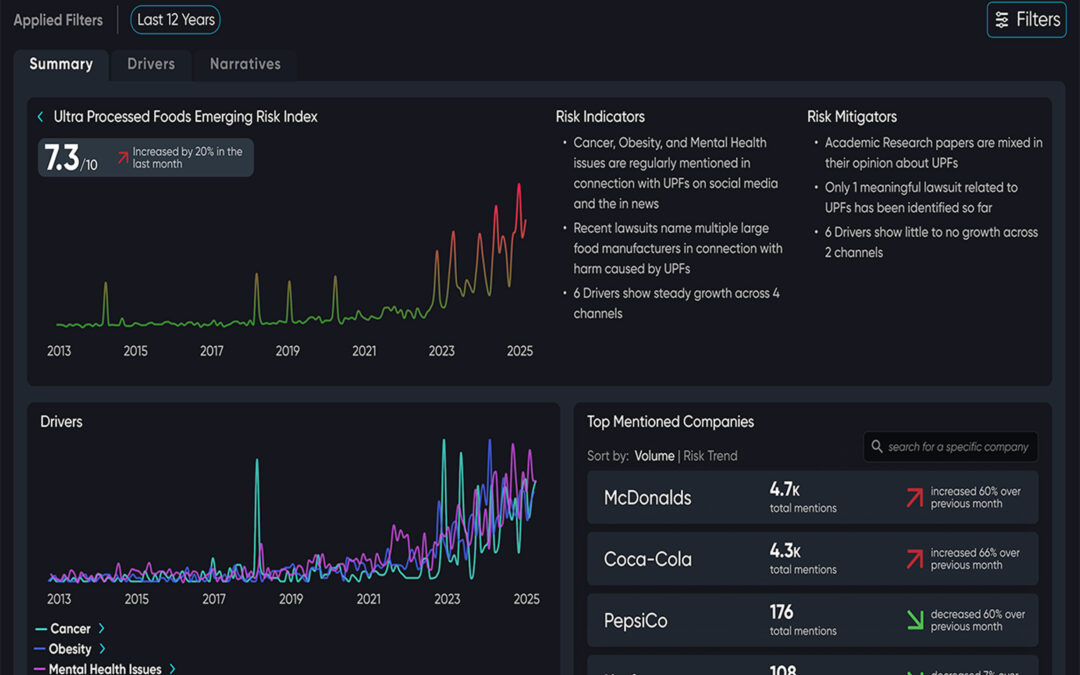
Advancing Foresight: How RiskWise AI Quantifies Emerging Risk Drivers
Enter description of the article here.

Enter description of the article here.

The world is moving faster than ever, consumer preferences shift quickly, regulations land with little lead time, and supply chains bend under geopolitical and environmental shocks. Risk signals are everywhere, but they’re scattered, and hard to measure. RiskWise cuts through the noise. Powered by advanced AI agents, large language models, and machine learning, it transforms weak signals into forward-looking risk intelligence that shows what’s about to escalate, what’s fading, and empowers analysts with data for decisions that matter the most. With RiskWise, organizations get clarity where it counts, smarter bets, faster moves, and a competitive edge built on foresight, not guesswork.

The rise of AI agents and hyper-automation is fundamentally reshaping how organizations surface, analyze, and act on risk. With nearly half of AI-assisted tasks now fully automated and enterprise adoption accelerating, risk intelligence can no longer rely on manual workflows or siloed data. RiskWise is built for this shift. By combining high-recall retrieval pipelines, proprietary LLM-driven agents, and dynamic risk indices, RiskWise transforms vast, heterogeneous datasets into structured, actionable risk insights. From uncovering hidden risk drivers to modeling cross-industry causal chains, RiskWise enables organizations to move beyond reactive monitoring toward proactive, agent-driven risk discovery. This post explores how RiskWise delivers scalable, future-ready intelligence for decision-makers navigating the era of hyper-automation.

Forecasting across hierarchical levels — for example, national, retailer, and category — is often inconsistent and inaccurate when done independently. We show, via a CPG case study, how applying hierarchical reconciliation methods with Tickr’s Forecasting Platform improves forecasting accuracy by an average of 14.9% enabling better business decisions.

Traditional CPG forecasting is slow, manual, and often relies on intuition rather than data-driven insights. Our AI-powered solution automates scenario planning, cutting weeks of effort down to hours. Using machine learning, it identifies key factors—like competitor pricing and economic trends—while ChatCPG’s AI agents generate scenarios and provide clear, actionable insights. This streamlined approach enables faster, smarter decision-making, helping businesses confidently navigate market shifts.

Tickr’s Dynamic Hierarchical Product Categorization offers CPGs and retailers a scalable, AI-powered solution that automates the task of categorizing products across evolving categories, significantly reducing manual effort and operational costs. Utilizing Tickr-LLM-base and Tickr-LLM-fine-tuned, the system achieves up to 98.1% accuracy, outperforming leading models like GPT-4o and Claude Sonnet 3.5. This superior performance enables businesses to streamline processes, enhance efficiency, improve downstream data science applications and reducing time spent on maintenance.

Shopper Journey Data provides insights into why shoppers choose to purchase certain products at specific Retailers over others. Analyzing timestamps and basket-level purchases from the Ohio region, allows us to observe whether shoppers make subsequent trips for specific products on the same day. Our findings illustrate that walk-out rates vary by retailer, food category, and brand. Convenience and dollar stores have higher walk-out rates compared to grocery stores, likely due to their smaller size and limited assortments. Certain food categories have greater variation in walk-out rates across retailers, indicating that certain retailers are better at capturing the appropriate product assortment or provide more appealing pricing and promotions.
This post addresses the challenge of identifying substitutable goods in consumer behavior analysis by leveraging large-scale shopping cart data. We introduce a sequential probabilistic model called “SHOPPER” developed by Ruiz, Athey, and Blei, to analyze hundreds of thousands of shopping trips encompassing millions of transactions. Our approach captures the complexity of consumer purchase behavior, considering various factors such as shopping purpose, seasonal variations, in-store promotions, and personal preferences.
In a previous post, substitutable goods were identified by leveraging large-scale shopping cart data to estimate a sequential probabilistic model called “SHOPPER,” developed by Ruiz, Athey, and Blei. In this post, the analysis is expanded by analyzing shopping cart data from several retailers across various geographical regions. Similar products are queried to investigate how the ranked lists of substitutable products vary across different retailers and geographies. These results provide insights into what products are substituted at various retailers and for the same retailers in different geographies.
By creating a retrieval augmented LLM pipeline, (RAG with OpenAI’s GPT-4o), we explored the capability of LLMs to ‘twin’ real respondents in a publicly available survey. By providing the model context of previously answered questions from a particular respondent, we were able to achieve far better than random accuracy at masked questions. This opens the door to utilizing LLMs to augment known sentiment, extending surveys beyond the original question set and providing a far more flexible framework for working with qualitative data from real respondents and their ‘digital twins’.
At Tickr, we enhance the data science life cycle using large language models (LLMs). We develop a solution, Generative Predictor Search (GPS), which integrates LLMs to improve the accuracy and efficiency of time series forecasts and provides intuitive interpretations of influential factors on forecasted variables. This approach not only reduces forecasting errors by 15.6% compared to naive univariate autoregression models but decreases run time by 13 times, establishing GPS as a leading solution in explainable forecasting.
Current data analysis is complex and inaccessible for most CPG decision-makers. This post proposes an AI powered learning assistant that bridges the gap. It combines large language models with CPG expertise to answer user questions and automate complex analyses. The assistant learns from user interactions, building a “collective intelligence” that empowers the entire organization. This technology has the potential to transform how CPG companies leverage data for better decision-making.
This article explores how Generative AI (genAI) can enhance traditional Machine Learning (ML) in solving complex problems faced by CPGs and Retailers. By providing common sense summaries of the patterns uncovered by ML as well as providing a way to dialogue with ML models, genAI can build your (human) team’s intuition about root causes, deepen trust between CPGs and retailers around forecasts, and increase alignment on complex pricing and promotional strategies.
This article delves into the critical aspects of Security & Data Management and Choosing the Right AI Partner for CPGs looking to adopt AI. We emphasize the importance of safeguarding data with robust security measures and selecting an AI partner with deep domain expertise, experienced in building tailored AI solutions, and a forward-looking approach to AI, data science, and technology. Tickr is positioned as a leader in integrating Generative AI and Data Science into the CPG industry, offering secure, customized, and scalable AI solutions to drive strategic decision-making and operational efficiency.
Integrating Generative AI and Data Science is pivotal for innovative decision-making and enhanced market understanding. This empowers CPGs with capabilities like predictive analysis, explainable forecasting, and efficient data-driven strategies through AI assistants. However, it’s crucial to understand the nuances of data sourcing, the distinct roles of Generative AI versus Data Science, and the importance of choosing the right data providers. Tickr’s expertise highlights the transformative potential of these technologies in CPG operations, offering a roadmap for effective and responsible adoption.
Large language models (LLMs) have shown great promise in being able to simplify business analytics workflows. Powerful third-party foundational models are being equipped to perform analytic tasks such as data cleansing, model selection and optimization, chart generation, etc. However, there are barriers that must be overcome before there is a large scale enterprise level adoption.
This article emphasizes the crucial role of managing wait times in software UX design, particularly in the context of the competitive modern web where user engagement can be significantly impacted by loading delays. It highlights the irony that Large Language Models (LLMs), despite being a breakthrough in software technology, inherently introduce longer wait times, challenging traditional UX principles.
Queues are a pattern that have been used at Tickr since the early days of the company. Much of the work we do at Tickr is in the background: data retrieval, alerting, processing incoming webhooks, and many more activities that don’t follow the typical request-response pattern found in many typical applications.
Tickr’s Marketing Causal Impact Analysis uses state-of-the-art machine learning to extract the true effect of a marketing campaign on sales, ROI, or any business metric relevant to our customers. This empowers them to make confident and better marketing decisions that lead to increased sales or ROI.
Time series data forms a critical component of business analytics, and in our pursuit of efficiency, we chose to evaluate TimescaleDB.
In today’s data-driven world, businesses are increasingly turning to advanced technologies to gain a competitive edge. Large language models (“LLMs”) have emerged as a game-changer, enabling businesses to have intelligent conversations with data and extract valuable insights. In this study we explore the effects of LLM temperature, a concept borrowed from statistical physics and thermodynamics, on the impact of LLM business applications.
Large language models (LLMs) are revolutionizing and automating the field of data analysis & knowledge-intensive tasks. The realm of Consumer Packaged Goods (CPG) is ripe for large transformational gains leveraging large language models. In this study we run a double-blinded experiment to assess the transformational capabilities of LLM systems.